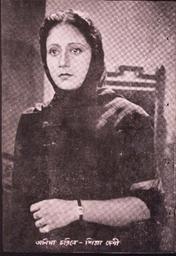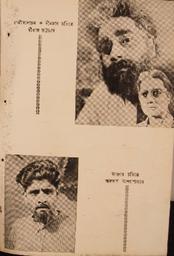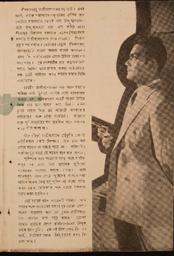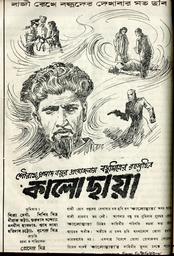Kalo Chhaya (1948)
Director: Premendra Mitra; Writer: Premendra Mitra; Producer: Gouranga Prasad Basu; Cinematographer: Bibhuti Das; Editor: Binoy Bandyopadhyay; Cast: Gurudas Bannerjee, Dhiraj Bhattacharya, Sipra Mitra, Sisir Mitra, Haridas Chattopadhayay, Nabadwip Halder, Shyam Laha, Nripendragopal Murari Mukhopadhyay, Nani Majumdar, Khitish Nag
Duration: 01:32:46; Aspect Ratio: 1.335:1; Hue: 40.585; Saturation: 0.002; Lightness: 0.308; Volume: 0.206; Cuts per Minute: 4.430; Words per Minute: 79.600
Summary: One of the early examples of the country-house mystery in Bengali cinema, Kalochhaya received consistent praise at the time of its release despite criticisms regarding its plot and writing primarily because it ushered in a new genre, breaking out of the family or social melodramas that dominated the era. An ailing zamindar Rajiblochan (Dhiraj Bhattacharya) calls for the services of a private detective Surojit Roy (Sisir Mitra) fearing that his life is in danger. However, even before the detective can get to his job the zamindar is murdered and the suspicion consequently falls on the menagerie of individuals who inhabit the house: the nurse who had earlier approached the detective to still the zamindar's will, the shady doctor who has abandoned everything to come live in the middle of nowhere, the Chinese cook who cannot speak in any other language, the disfigured older brother who had been estranged for years but had recently come for shelter after being struck down by the consequences of his ill-spent youth. Add to this the deceased's last will and testament which is stolen the same night, the manager who is brutally murdered soon after and a shadowy masked figure who is often seen in the house but seems to disappear into thin air immediately after.
Release date: 17 December, 1948 (Minar; Bijoli; Chhabighar)









Kalochhaya was one of the first thrillers made by Premendra Mitra. Immensely successful at the time of its release, the film was particularly praised for bringing the genre of thriller into the forefront, thus breaking away from socials or mythologicals which were the norm of the day. Thus, despite certain plot loopholes, the narrative and the director garnered praise. A typical country-house mystery, the detective in this narrative, unlike Mitra's later films like 'Hanabari', is not just the sleuth that brings about the denoement but also is the hero-figure whose union with the heroine would generally signal the typical 'happy ending'. However, made at a time when film noir was taking the world by storm, elements of that genre can also be seen here, especially the opening scene with the sleuth and the mysterious femme-fatale who comes with a rather odd and less than legal request, setting the stage of such a narrative which generally revolves around a particular set of characters, all of whom have some sort of secret to hide or some sort of unsavoury past to protect.

The scene is immediately followed by an invitation for the detective to visit a man who, it becomes obvious, is the same man the woman had asked him to steal from in the earlier scene. This sets the stage for the central conflict in the narrative which transpires in the next scene and moves the action to the setting where the rest of the narrative will unfold.

The country house, where the rest of the story will unfold. The scene is crucial for a number of reasons. Firstly, it introduces the main players - the ailing landlord, the elder brother who had been banished for his excesses and who has now returned ill and destitute, the doctor who inexplicably has abandoned the city to come and live in the middle of nowhere, the strange cook who can speak only in Chinese - a curious menagerie that only serves to underline the titular shadow that seems to hang over the house. Secondly, the scene also introduces the primary conflict, that of property and disinheritance. The older brother had been cast out because of his behaviour and he has now come back destitute, paralysed and looking for shelter. He is severely ill, it is insinuated that the excesses of his youth have ravaged his body so much that he does not have much time left. At the same time, the narrative seems to point to the fact that Rajivlochan himself may not have been completely above board in the way he had come to be made the sole heir to the property. A third younger brother is mentioned in this regard and how he too had been similarly disinherited. Nevertheless, it becomes quite clear that Rajivlochan, despite his fear and anxiety, is a rather strong man himself in the way he has surrounded himself with ways to protect himself from harm. The cleverly spliced shots of the twin brothers together, one agitated and angry and the other helpless and begging, are necessary of course to establish this conflict.

The murder happens only two scenes later, and sets the narrative in motion. A series of things need to be noted here. Firstly, the palpable tension that is immediately observable between the detective and the doctor. It is very obvious they don't trust each other right at the outset and even though he seems to be content for the time being on knowing the detective's identity, it rather obvious the doctor can do without his interference. Secondly, the sleuth also comes face to face with the femme-fatale he had met in the opening scene much to both their surprise, her more than him. Finally, Mitra manages to move between various sub-genres of thrillers, with the elements of noir, country-house mystery and melodrama all floating into each other. The interrogation is the best example of this, not only of the mysterious woman but every odd-ball character that is part of the household.

This long sequence of the woman stealing something from the dead man's room is shot mostly through an interplay of light and shadows, an early staple of the noir genre. The woman's identity and motives have already been brought to question right from the very beginning and all that seems to congeal through her nocturnal escapade.

However, in a clear departure from the tropes of early noir the mysterious woman is immediately absolved of most of her suspicions in the very next scene. In fact, the function that this character performs is manifold - she reminds everyone of the need to re-investigate the impulses of the dead man rather than absolve him of all accusations and she also provides a backstory and context for such a re-evaluation with the tale she relates about the three brothers. One can of course argue that it does nothing to remove all doubts from her. However, the way the scene is framed around this particular conversation leaves very little future possibilty of seeing the woman as anything but an assistant-figure for the sleuth.

This fact is underlined by the appearance of the black shadowy masked figure that gives the film it's name. Seen first while eavesdropping through the window while the nurse is recounting her tale of the three brothers, the figure's sudden disappearance into thin air drives home the fact that it is possible that Anima is telling the truth and something far more sinister is afoot. As mentioned earlier, within the space of a scene nurse Anima has emerged more as an accomplice for the sleuth rather than as a suspect.

The three scenes with the doctor, the paralysed brother Dinanath and the manager are interesting in how the narrative is attempting to place these three in the context of all that has just happened since they are the prime suspects left. In this case, it is quite obvious where the doctor stands because neither him nor the detective seem to trust each other. Dinanath and the manager, on the other hand, corroborate the presence of the masked shadow and the presence of something supernatural in the recent incidents.

The revelation that Rajivlochan had been charged with bank fraud and the police have come to arrest him rather than to investigate his murder places nurse Anima's claims in the earlier scene about Rajivlochan's crimes on the forefront.

The arrival of the masked figure and its subsequent disappearances at various points in the film serve two crucial functions. At the very basic level it works as a way of heightening the terror and mystery that has been hitherto built up in the narrative what with the image of a shadowy creature, perhaps human, lurking about in the darkness and disappearing just as easily. At the same time, the shadow creature also symbolizes a sort of disruption, a rupture in the patterns of the everyday that refuses to be contained. This latter tendency is best seen in the immediate reactions of the people who gather after its disappearance. Accusations and counter-accusations fly and secrets of hidden passage-ways and nefarious plans are revealed. In a way the shadowy figure can be seen as both a source of chaos or disruption and a symbol of the dark, hidden secrets that seem to shroud the house itself.

Suspicions around the doctor have already gained significant ground. It remains unanswered why he has been here all this while and his reactions to the detective's presence has only served to increase that suspicion. The fact that the detective chooses to search his rooms underlines that fact.

Since the previous few scenes have deliberately tried to have the supicion swirl around a particular set of people, the revelation that the Chinese cook is not so Chinese after all but is in fact a man pretending to be so just to escape being interrogated does not really cause the intrigue it could have. Furthermore, the actor is Shyam Laha who along with Nabadwip Halder was one of the foremost comedy double acts of the time. So, in a rather amusing scene which serves as a comic interlude in the narrative, the two smoke what seems like marijuana and hallucinate a series of things. Besides, one of the hallucinations is of the masked shadow himself and the comic interlude quickly gives way to another murder.

Again, the arrival of the masked entity brings forth chaos, terror and disorder. Almost in a repetition of the preceding scene, accusations are thrown and most of them settle around the doctor yet again. This will be repeated again after two scenes when after a prolonged fight the figure manages to injure the detective and escape and the doctor is the first to arrive at the scene.

This short scene serves two important functions: firstly, Anima's vehement refusal of the doctor injecting Surojit is proof of how much the suspicion against the doctor has spread. However, more importantly, Surojit's feigning illness with Anima and her consequent worry over his ill-health has obvious romantic connotations between the two, something that was expected but had hitherto not been dwelt upon. Thus, this scene acts more like a small break in proceedings to establish the central couple with the possibilty of some sort of a romantic relationship. The focus immediately shifts to the masked intruder and the primary narrative in the very next scene.

The scene serves as a roster: while the two characters express their distrust and barely suppressed hostility to each other, it also provides a opportunity for the audience to examine every detailed and minor information that has been learned till now, and examine each and every person who has been declared a suspect. The thrust is of course still on the doctor but it's also a clever little scene that serves to summarize all the major plot points that have come up till now and anticipate the final blow by way of the will that is mentioned which is to be read the next day.

The reading of the will is a crucial event in more ways than one. Firstly, this is the will Anima had stolen. Thus one can infer that the shadowy thief for some mysterious reason had chosen to keep the will back where it was after having stolen it back from Anima. Besides, with the revelation of Anima's identity as the lost younger son Pitambar's daughter, according to the new rules of inheritence she becomes an equal beneficiary. Finally, the doctor's arrest sets the stage for the climax.

The doctor's agitation, rather than proving his guilt, signals towards a differnet set of conclusions. This is corroborated by his reaction to the telegram, something he had clearly been waiting for, and his subsequent escape.

The cliamctic unmasking is not just a revelation of the actual culprit but an unmasking across various levels. Since Dinanath had been the only person to know of Surojit's ruse to switch rooms, the attack by the masked entity that very night would obviously evoke an expected set of responses. What would be less expected, and hence more shocking, would be the revelation that it had been Rajivlochan all along. At the same time, the other crucial unmasking would be that of the doctor as the youngest brother Pitambar who had come back for revenge. Since the black shadow had been a symbol of disorder, the unmasking immediately is a re-establishment of that upset order and the most perfect outcome of that order is the re-union of wayward, repentant father and son.

The final scene is in many ways a deliberate effort to acknowledge the romantic relationship between Surojit and Anima which has been variously hinted at throughout the film. With order having been restored it acknowledges the new family unit that has emerged from it, Pitambar and his long-lost daughter, and brings the narrative to a full-circle. The film had begun in a similar manner with her coming to him for assistance and it ends similarly, albeit as a prank.
Indiancine.ma requires JavaScript.